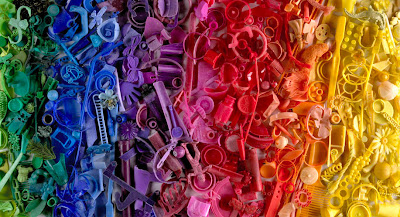In the studio we sort first for color- the subtle gradations of rust to red, from fuscia to pink. When presenting our collection of plastic we are frequently asked if we did something to the color? Never!!! From the brilliant yellow of a toothbrush handle to the cobalt blue of single use water bottle lid- the unlimited hues are what makes for a great palette of plastic.
In his poem FLESH, Richard muses on his childhood relationship to crayons and color.
FLESH
It wasn't that the color didn't match
‘cause it wasn't called skin.
It was called flesh though it seemed flesh
didn't have much to do
with the color of skin.
Flesh was the stuff under the skin,
and anyway people weren't white.
People weren't black or red or yellow.
The skin of people was brown or coffee
or pale amber or tanned pink.
And old Binney & Smith in 1903
when the first crayon hit the scene
the box only HAD eight colors,
the usual ones, but the post-war big-box
had Flesh in it with the other 47.
Flesh was changed to Peach in 1962
and no Negro color replaced it
or yellow-man color
which reminds me of sitting
in a Pittsburgh hot dog joint.
At the next table an African-American boy
playing I-spy-with-my-little-eye,
saying “Brown” and pointing to his sister,
his mamma says, "No, baby, she yellow."
opening my eyes to the austere hierarchy
invisible to most of us with pale skin.
And Crayola dropped the Indian Red name
as a political correction in 1958
even though it was named
for a kind of iron oxide found in India.
And stuck in my brain is a swirling rainbow
of color like oil on water catching the light.
Skin of the "colored man"
my mama said was coming by
to do the lawn.
Disappointed that it was the open-hearted Major,
though I was always glad to see him,
an African-American man who
was kind to kids,
and had really been a Major in the war,
these days, mowing lawns.
He was no colored man though I kept looking
and maybe my mama was right,
if he would catch the light just so. . .
To this day my mind holds a picture
tight to itself of the real rainbow-colored man.
Finally, it was that eight year old
holding a hard tube of crayon in 1956
and saying over and over flesh, flesh.
Flesh was meat and I half expected it
to have the flow of warm blood pulsing.
And even now when I hear the word flesh,
I think of that peachy cylinder.
As in, the way of all flesh,
or sins of the flesh,
or in the flesh,
or flesh and blood,
and flesh eating bacteria,
or pressing the flesh,
and flesh and bones,
and, "Oh that this too too solid flesh would melt . . ."
and that pound of flesh Shylock
hoped would be the heart of Antonio,
And, come to think of it, just
how does the dark substance of my flesh
become these colorful thoughts,
the flesh of this poem.
Thanks to Sarah Ratchye for embodying the rainbow.

